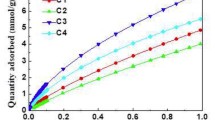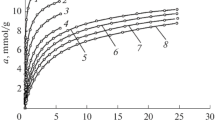Abstract
Four nanoporous carbons obtained from different polymers: polypyrrole, polyvinylidene fluoride, sulfonated styrene–divinylbenzene resin, and phenol–formaldehyde resin, were investigated as potential adsorbents for carbon dioxide. CO2 adsorption isotherms measured at eight temperatures between 0 and 60 °C were used to study adsorption properties of these polymer-derived carbons, especially CO2 uptakes at ambient pressure and different temperatures, working capacity, and isosteric heat of adsorption. The specific surface areas and the volumes of micropores and ultramicropores estimated for these materials by using the density functional theory-based software for pore size analysis ranged from 840 to 1990 m2 g−1, from 0.22 to 1.47 cm3 g−1, and from 0.18 to 0.64 cm3 g−1, respectively. The observed differences in the nanoporosity of these carbons had a pronounced effect on the CO2 adsorption properties. The highest CO2 uptakes, 6.92 mmol g−1 (0 °C, 1 atm) and 1.89 mmol g−1 (60 °C, 1 atm), were obtained for the polypyrrole-derived activated carbon prepared through a single carbonization-KOH activation step. The working capacity for this adsorbent was estimated to be 3.70 mmol g−1. Depending on the adsorbent, the CO2 isosteric heats of adsorption varied from 32.9 to 16.3 kJ mol−1 in 0–2.5 mmol g−1 range. Overall, the carbons studied showed well-developed microporosity and exceptional CO2 adsorption, which make them viable candidates for CO2 capture, and for other adsorption and environmental-related applications.




Similar content being viewed by others
References
Aaron, D., Tsouris, C.: Separation of CO2 from flue gas: a review. Sep. Sci. Technol. 40, 321–348 (2005)
Arienillas, A., Rubiera, F., Parra, J.B., Ania, C.O., Pils, J.J.: Surface modification of low cost carbons for their application in the environmental protection. Appl. Surf. Sci. 252, 619–624 (2005)
Brunauer, S., Emmett, P.H., Teller, E.: Adsorption of gases in multimolecular layers. J. Am. Chem. Soc. 60, 309–319 (1938)
Choma, J., Kalinowska, A., Jedynak, K., Jaroniec, M.: Reproducibility of the synthesis and adsorption properties of ordered mesoporous carbons obtained by the soft-templating method (in Polish). Ochr. Srodowiska 34(3), 3–10 (2012)
Choma, J., Osuchowski, L., Jaroniec, M.: Properties and applications of activated carbons obtained from polymeric materials: a review (in Polish). Ochr. Srodowiska 36(2), 3–16 (2014a)
Choma, J., Osuchowski, L., Marszewski, M., Jaroniec, M.: Highly microporous polymer-based carbons from CO2 and H2 adsorption. RSC Advances 4, 14795–14802 (2014b)
Choma, J., Stachurska, K., Osuchowski, L., Dziura, A., Jaroniec, M.: Carbon dioxide adsorption on activated carbons obtained from polymeric precursors (in Polish). Ochr. Srodowiska 37(4), 3–8 (2015)
De Canck, E., Ascoop, I., Sayari, A., Van Der Voort, P.: Periodic mesoporous organosilicas functionalized with a wide variety of amines for CO2 adsorption. Phys. Chem. Chem. Phys. 15, 9792–9799 (2013)
De Souza, L.K.C., Wickramaratne, N.P., Ello, A.S., Costa, M.J.F., da Costa, C.E.F., Jaroniec, M.: Enhancement of CO2 adsorption on phenolic resin-based mesoporous carbons by KOH activation. Carbon 65, 334–340 (2013)
Górka, J., Jaroniec, M.: Hierarchically porous phenolic resin-based carbons obtained by block copolymer-colloidal silica templating and post-synthesis activation with carbon dioxide and water vapor. Carbon 49, 154–160 (2011)
Gupta, V.K., Nayak, A., Agarwal, S., Tyagi, I.: Potential of activated carbon from waste rubber tire for the adsorption of phenolics: effect of pre-treatment conditions. J. Colloid Interface Sci. 417, 420–430 (2014)
Heydari-Gorji, A., Belmabkhout, Y., Sayari, A.: Polyethyleneimine-impregneted mesoporous silica: effect of amine loading and surface alkyl chains on CO2 adsorption. Langmuir 27, 12411–12416 (2011)
ICPP, Climate Change 2013: The Physical Science Basis. Contribution of Working Group I to the Fifth Assessment Report of the Intergovernmental Panel of Climate Change, Cambridge University Press, Cambridge, United Kingdom and New York, 2013
Jagiello, J., Olivier, J.P.: 2D-NLDFT Adsorption models for carbon slit-shaped pores with surface energetical heterogeneity and geometrical corrugation. Carbon 55, 70–80 (2013a)
Jagiello, J., Olivier, J.P.: Carbon slit pore model incorporating surface energetical heterogeneity and geometrical corrugation. Adsorption 19, 777–783 (2013b)
Jankowska, H., Swiatkowski, A., Choma, J.: Active Carbon. Ellis Horwood Ltd., Chichester (1991)
Kruk, M., Jaroniec, M.: Gas adsorption characterization of ordered organic–inorganic nanocomposite materials. Chem. Mater. 13, 3169–3183 (2001)
Lee, S., Park, S.: Determination of the optimal pore size for improved CO2 adsorption in activated carbon fibers. J. Colloid Interface Sci. 389, 230–235 (2013)
Liu, J., Thallapally, P.K., McGrail, B.P., Brown, D.R., Liu, J.: Progress in adsorption-based CO2 capture by metal-organic frameworks. Chem. Soc. Rev. 41, 2308–2322 (2012)
Liu, J., Wickramaratne, N.P., Qiao, S.Z., Jaroniec, M.: Molecular-based design and emerging applications of nanoporous carbon spheres. Nat. Mater. 14, 763–774 (2015)
Ludwinowicz, J., Jaroniec, M.: Potassium salt-assisted synthesis of highly microporous carbon spheres for CO2 adsorption. Carbon 82, 297–303 (2015a)
Ludwinowicz, J., Jaroniec, M.: Effect of activating agents on the development of microporosity in polymeric-based carbon for CO2 adsorption. Carbon 94, 673–679 (2015b)
Marsh, H., Rodriguez-Reinoso, F.: Activated Carbon. Elsevier, Amsterdam (2006)
Migahead, M.A., Abdul-Raheim, A.M., Atta, A.M., Brostow, W.: Synthesis and evaluation of a new water soluble corrosion inhibitor from recycled poly(ethylene terephthalate). Mater. Chem. Phys. 121, 208–214 (2010)
Mishra, S., Goje, A.S., Zope, V.S.: Chemical recycling, kinetics, and thermodynamics of poly(ethylene terephthalate) (PET) waste powder by nitric acid hydrolysis. Polym. React. Eng. 11, 79–99 (2003)
Myers, A.L.: Thermodynamics of adsorption in porous materials. AIChE J. 48, 145–160 (2002)
Patel, H.A., Karadas, F., Canlier, A., Park, J., Deniz, E., Jung, Y., Atilhan, M., Yavuz, C.T.: High capacity carbon dioxide adsorption by inexpensive covalent organic polymers. J. Mater. Chem. 22, 8431–8437 (2012)
Piacentini, R.D., Mujumdar, A.S.: Climate change and drying of agricultural products. Drying Technol. 27, 629–635 (2009)
Samanta, A., Zhao, A., Shimizu, G.K.H., Sarkar, P., Gupta, R.: Post-combustion CO2 capture using solid sorbents: a review. Ind. Eng. Chem. Res. 51, 1438–1463 (2012)
Seredych, M., Jagiello, J., Bandosz, T.J.: Complexity of CO2 adsorption on nanoporous sulfur-doped carbons—is surface chemistry an important factor? Carbon 74, 207–217 (2014)
Su, F., Lu, C.: CO2 capture from gas stream by zeolite 13x using a dual-column temperature/vacuum swing adsorption. Energy Environ. Sci. 5, 9021–9027 (2012)
Thommes, M., Kaneko, K., Neimark, A.V., Olivier, J.P., Rodriguez-Reinoso, F., Rouquerol, J., Sing, K.S.W.: Physisorption of gases, with special reference to the evaluation of surface area and pore size distribution (IUPAC Technical Report). Pure Appl. Chem. (2015). doi:10.1515/pac-2014-1117
Wang, X., Liang, C.D., Dai, S.: Facile synthesis of ordered mesoporous carbons with high thermal stability by self-assembly of resorcinol–formaldehyde and block copolymers under highly acidic conditions. Langmiur 24, 7500–7505 (2008)
Wickramaratne, N.P., Jaroniec, M.: Activated carbon spheres for CO2 adsorption. ACS Appl. Mater. Interfaces 5, 1849–1855 (2013)
Acknowledgments
J.C. acknowledges the National Science Centre (Poland) for support of this research under grant 2013/09/B/ST5/00076.
Author information
Authors and Affiliations
Corresponding author
Rights and permissions
About this article
Cite this article
Choma, J., Stachurska, K., Marszewski, M. et al. Equilibrium isotherms and isosteric heat for CO2 adsorption on nanoporous carbons from polymers. Adsorption 22, 581–588 (2016). https://doi.org/10.1007/s10450-015-9734-0
Received:
Revised:
Accepted:
Published:
Issue Date:
DOI: https://doi.org/10.1007/s10450-015-9734-0




